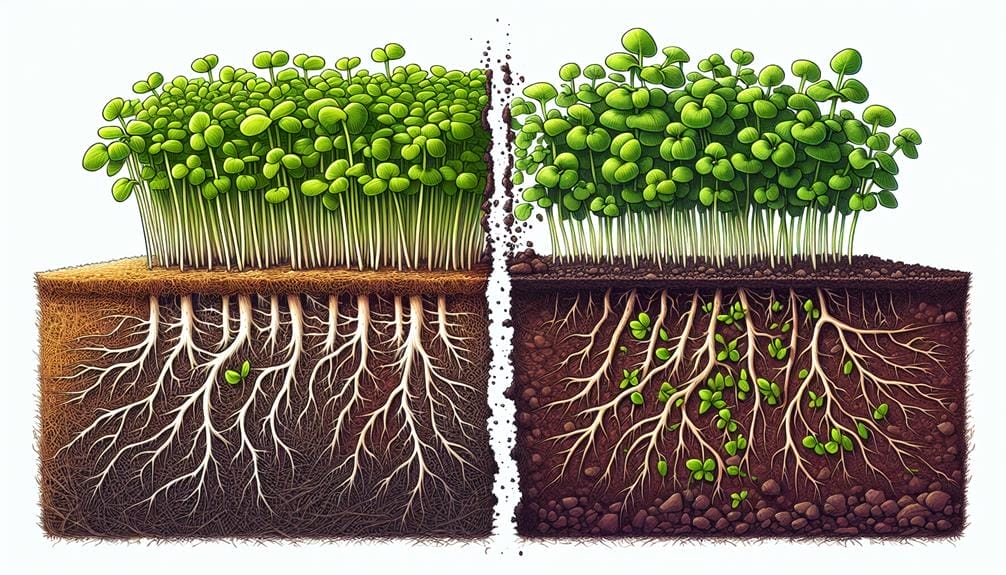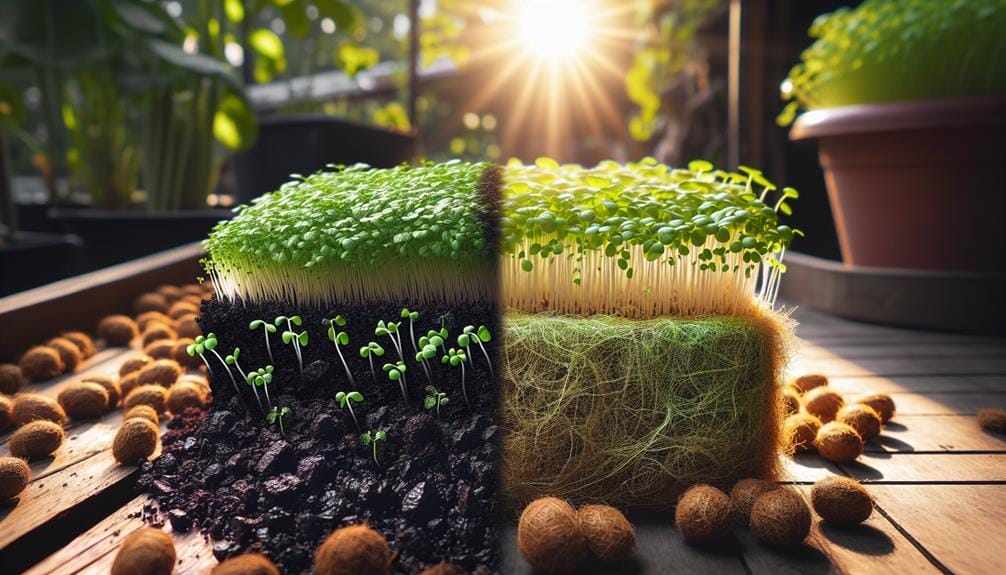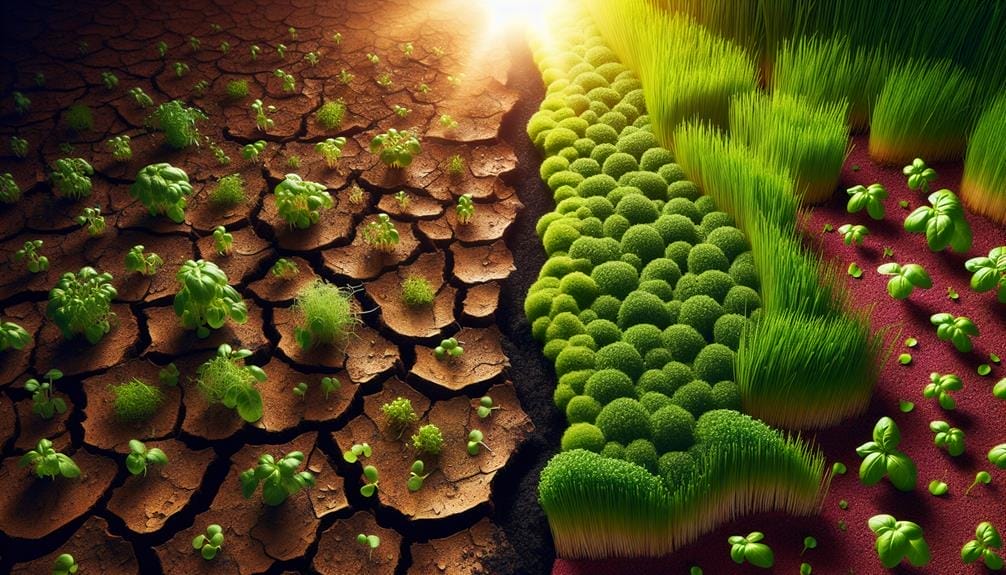Coco Coir Vs Soil for Microgreens
In the world of microgreens, the debate between coco coir and soil is akin to choosing between water and wine for a gourmet meal; both have their unique merits and can significantly influence the final outcome.
You’re standing at a crossroads, with eco-friendliness and water retention championing coco coir on one side, and the traditional, nutrient-rich allure of soil on the other.
As you weigh sustainability against ease of use and the desire for organic methods, remember, the choice you make could redefine your microgreen growing experience.
Uncover which medium truly aligns with your gardening philosophy and goals, and let that guide your decision.
Understanding Microgreens

Microgreens, young green vegetables harvested early for their nutrient richness and flavor, pack a more concentrated vitamin and nutrient punch than their mature counterparts.
You’re striving to master their cultivation, and the choice between coco coir and soil is pivotal. Coco coir, a versatile growing medium, offers distinct advantages for microgreens. Compared to soil, coco coir provides superior water retention and aeration, crucial factors in the early growth stages.
When using coco coir, you’ll find it easier to maintain the optimal moisture level, promoting faster germination and growth without the risk of overwatering. Furthermore, coco coir mats simplify the process, offering a clean, sustainable alternative to traditional soil.
Embrace coco coir for its efficiency and eco-friendliness in elevating your microgreens’ growth.
Coco Coir Explained
Having explored the benefits of coco coir for microgreen cultivation, let’s now take a closer look at what coco coir actually is and why it’s such an effective growing medium.
- Coconut Coir – It’s a lightweight, organic material derived from discarded coconut husks, making it an environmentally friendly choice.
- Water Retention – Coco coir retains water without causing excess, ensuring your microgreens receive the perfect amount of moisture.
- Excellent Aeration – Its structure promotes excellent aeration, crucial for healthy root development and the overall growth of your microgreens.
- Neutral pH & Cost-Effectiveness – With a neutral pH and being more cost-effective than cocomats, coco coir stands out as a good option for both novice and experienced growers aiming for high-quality, healthy microgreens.
Benefits of Coco Coir

Exploring the benefits of coco coir reveals why it’s become a top choice for growing microgreens efficiently and sustainably. Coco Coir comes from coconut husks, offering a lightweight, organic potting solution that’s easy to use. Its capacity to hold moisture, without becoming waterlogged, ensures your microgreens’ roots develop healthily.
Moreover, this medium provides excellent aeration to the roots, facilitating optimal growth and nutrient uptake essential for microgreen growing. Its clean, easy-to-store nature makes it a cost-effective, sustainable option, especially favored in hydroponic growing systems. By choosing coco coir, you’re not just opting for an efficient growing medium; you’re embracing a sustainable approach to cultivating microgreens, aligning with your mastery goals in gardening.
Challenges With Coco Coir
While coco coir offers numerous benefits for growing microgreens, it’s not without its challenges. Here’s a quick rundown:
- Nutrient Addition: Unlike soil, coco coir doesn’t naturally contain nutrients vital for lush microgreen growth. You’ll need to incorporate a balanced mix to ensure your greens thrive.
- Time for Expansion: Before you can dive into cultivation, coco coir requires time and effort to expand. It’s not a grab-and-go medium.
- Cost-Effectiveness: Although generally more affordable than cocomats, remember that the need for additional nutrients might offset the initial lower cost.
- Water Retention: Coco coir’s excellent water retention is a double-edged sword. It necessitates careful nutrient management to prevent waterlogged conditions that could hinder optimal microgreen growth.
Mastering coco coir for microgreens means navigating these hurdles for successful cultivation, especially if targeting high-end restaurants.
Soil Basics

Soil, typically costing around $1 per 1020 tray, offers an affordable and widely preferred medium for organic microgreen cultivation. When you mix it with perlite, the soil retains moisture effectively, ensuring predictable growth across various microgreen varieties. This versatility makes soil an excellent choice for both indoor and outdoor gardening. You’ll find that some microgreens thrive better in soil than in hydroponic setups, giving you a broader palette for your gardening projects.
Despite its benefits, you should be aware of soil’s messy disposal and the challenge it poses when selling live microgreens. However, its ability to be reused in outdoor gardens without additional nutrient amendments showcases its sustainability. As you master your gardening skills, understanding soil’s nutrient requirements and managing its drawbacks will become second nature in your pursuit of microgreen mastery.
Advantages of Soil
Considering its affordability, at roughly $1 per 1020 tray, soil stands as a cost-effective medium for cultivating microgreens. When you’re aiming to master the art of growing these nutritious greens, understanding the advantages of using soil can set you apart. Here’s why soil for microgreens is a top choice:
- Organic Growing Practices: Soil supports organic methods, crucial for those committed to sustainable agriculture.
- Moisture Retention: A mix of peat moss, potting mix, and perlite holds moisture well, offering consistent results.
- Optimal Growth: Certain microgreen varieties simply thrive in soil, outperforming hydroponic setups.
- Sustainability: Soil’s reusability for outdoor gardens marks it as an eco-friendly option.
Mastering microgreen trays with soil not only promises a greener footprint but also ensures your venture into organic growing is both fruitful and fulfilling.
Soil Limitations

Despite its benefits for growing microgreens, soil comes with certain drawbacks that might make you reconsider its use. The soil limitations, especially for those aiming to sell live microgreens to restaurants, are primarily centered around cleanliness concerns.
Disposal challenges of used soil present another significant drawback, as it’s not as straightforward as other mediums like coco coir. You’ll also find that soil can lead to messy trays, adding to your maintenance efforts and making it less ideal for indoor kitchen use.
While some microgreen varieties indeed prefer soil for predictable growth, the added effort in cleaning and disposing of soil mightn’t align with your aspirations for mastery in microgreen cultivation.
Coco Coir Vs Soil for Microgreens – Making the Right Choice
Given the limitations and benefits of both mediums, choosing between coco coir and soil for growing microgreens depends on your specific needs and goals.
Here are four key considerations:
- Coco coir excels in water retention and aeration, crucial for the delicate early stages of microgreens.
- Soil provides a cost-effective solution with consistent results, especially when enhanced with perlite.
- If you’re leaning towards hydroponic methods, remember that coco coir requires added nutrients but aligns well with cleanliness standards for direct sales to upscale markets.
- Hemp mats offer an alternative with effortless disposal and no need for additional nutrients, though they may not suit all microgreen varieties.
Your choice of growing medium—coco coir, soil, or even hemp mats—should align with your cultivation practices, market demands, and personal preferences for sustainable gardening.
Conclusion
So, you’ve danced through the dirt and cozied up to coco coir, weighing the world of microgreens beneath your green thumbs.
Here’s the twist: choosing between soil and coco coir is like deciding between chocolate and vanilla ice cream on a hot day. Both will cool you down, but your taste buds dictate the winner.
Whether you lean towards the earthy embrace of soil or the eco-chic vibe of coco coir, remember, it’s your garden’s party, and either way, you’re growing green.






